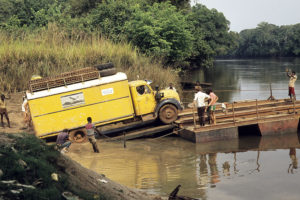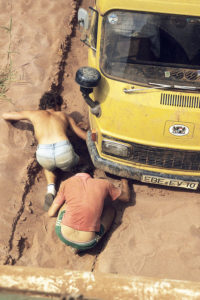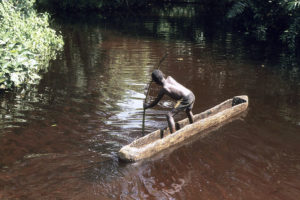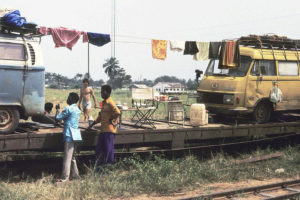Kaj Halberg - writer & photographer
Travels ‐ Landscapes ‐ Wildlife ‐ People
Africa 1980: An arduous journey across Africa
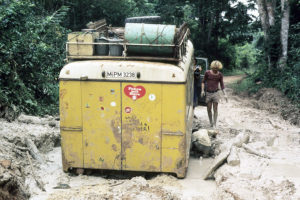
In the ancient city of Meknès, we make a stop to explore the medina, the old Muslim part of town. When we have parked our van, we are approached by three young men, who suggest that one of them will show us around in the medina, while the other two will guard our car. They assure us that their fee will be very low. We roam the narrow streets, in which countless traders display their goods. We also pay a visit to a mosque and a Koran School with beautifully carved beams, made from Atlas cedar wood (Cedrus atlantica), its walls adorned with Koranic texts. A few ruins in the city date back from the 14th Century.
Back at our van, the three young men suddenly display their true character. They now demand 30 Dirhams, instead of the 10 Dirhams that we agreed to pay. When we refuse, they declare that they will get hold of a policeman, to tell him that we have labelled King Hassan ‘stupid’. We have no fear of this threat, but the guys might harm our car. After lengthy negotiations we agree to a payment of 20 Dirhams. We then leave town, rather disappointed with Moroccans.
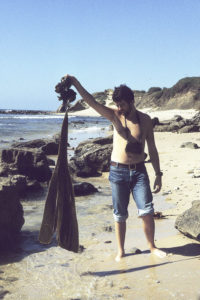

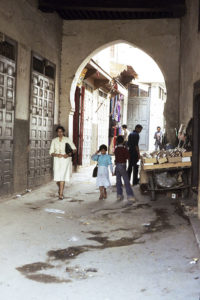

In north-western Algeria, we spend the night in our car at the road side. In the morning, a dense blanket of fog covers the landscape, but soon the sun makes an attempt to penetrate the fog, small dots of sunshine wandering over the hilly landscape, which alternates between wild, barren rocks, olive orchards, eucalyptus plantations, and pine woods. We then pass through rather flat, dry farmland, with long rows of planted plane trees (Platanus) and poplars (Populus).
The high plateau between Frenda and Aflou consists mainly of sand and gravel, where we encounter our first true desert birds, such as calandra lark (Melanocorypha calandra), Dupont’s lark (Chersophilus duponti), and brown-necked raven (Corvus ruficollis), the latter being somewhat smaller than the common raven (C. corax).
The following morning, two men approach our car, both carrying a sack on their shoulder. Using sign language, they ask us for a lift to the town of Laghouat. Steffen and I retreat to the cabin, whereas our two hitch-hikers occupy the front seat beside Johnny.
About a hundred km north of the oasis town of El Golea, sand becomes the dominating feature of the desert. A fierce wind is blowing sand across the road, and a sign, indicating that you may encounter sand on the road, seems rather superfluous. Dark clouds loom on the horizon, and soon rain starts falling. Rain in the Sahara! When we pass through villages, their inhabitants are dancing around in the streets, overjoyed. In this part of the world, people are as pleased with rain, as Westerners are with sunshine.
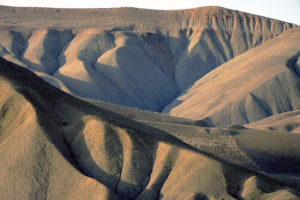
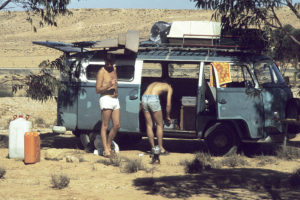
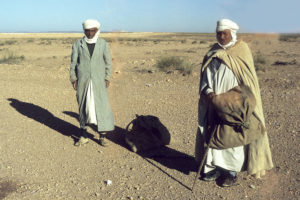
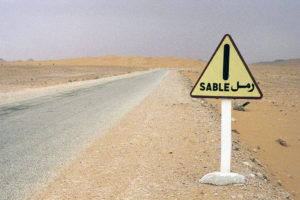

Ain Salah is an interesting town of adobe houses and narrow streets, with a square market place. The town is facing a serious problem, as wandering dunes are threatening to bury the town. We park for the night in a growth of date palms (Phoenix dactylifera) at the outskirts of town, where we observe palm doves (Spilopelia senegalensis), fulvous babblers (Turdoides fulva), and other birds.
Further south, around Arak, the landscape is rocky and dramatic, with thickets of tamarisk (Tamarix) and acacia, and scattered bushes of Sodom apple (Calotropis procera) with large, green fruits, from which downy seeds drift about in the wind. This fruit was first described by Roman historian Titus Flavius Josephus, born Yosef ben Matityahu (c. 37-100 A.D.), who found it growing near the city of Sodom: “which fruits have a color as if they were fit to be eaten, but if you pluck them with your hands, they dissolve into smoke and ashes.” (W. Whiston (1737): The War of the Jews, Book IV, chapter 8, sec. 4). Titus is referring to the fact that the ripe fruit easily dissolves, releasing hundreds of downy seeds, which are scattered to the four winds.
In this area, we encounter our first Tuareg people – locally called Imuhagh or Itargiyen – who ride on camels, the husband in front, clad in blue, wearing a scarf around his face, at the rear his wife, wearing gaily coloured clothes, but no scarf covering her face.
North of the town of Tamanrasset we enter the wild Hoggar Mountains, brown, barren, and eroded into the weirdest formations. Tamanrasset is not particularly interesting, but nevertheless we stay here a few days to do some shopping, before we have to cross the difficult desert area between here and northern Niger – a trip that can easily last several days. We camp at the outskirts of town, beneath shady trees, where other desert travellers also stay. Among these are 10 overlanders, driving in two huge trucks. Beneath the trees a tiny spring emerges, containing the most wonderful water. Most of it is used by the local inhabitants, the remaining water creating a small pool, where flocks of red-billed firefinches (Lagonosticta senegala) quench their thirst.
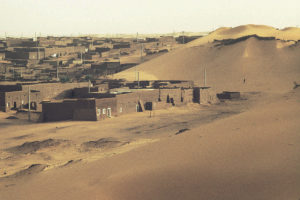
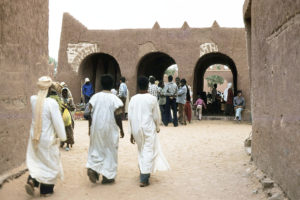

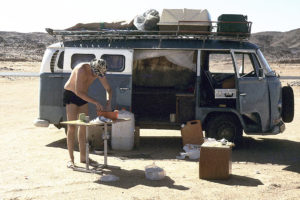

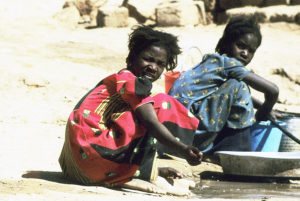
Our trip along the piste lasts four days. We often get stuck in soft sand, and a major part of the time is spent digging and pushing. From Europe, we brought aluminum sand ladders, which we place under the wheels, to give the tyres a better grip. During our hard work, in the intense heat, we sweat profusely, but we have ample drinking water. It’s our great luck to have joined company with the trucks, as they often pull out the smaller cars, when they get seriously stuck in the sand.
Our desert crossing is not without mishaps. As we are racing through soft sand, we suddenly encounter a wadi, a dried-out watercourse. Luckily, the bank is quite low, but when the car hits the ground, we hear an ominous cracking sound from the front part. A suspension bar between the front wheels has broken. Brian, a mechanic from one of the trucks, kneels down to investigate our car, declaring that the bar is not strictly necessary. This turns out to be true, as the rest of our trip across Africa is made without it.
Quite foolishly, the fuel tank on the Ford Transit, which belongs to the Italians, is placed beneath the car. One day, it is hit by a protruding stone, which pierces the tank, causing the diesel to pour out. This problem is quickly solved by Brian, who drills a hole in the floor of the cabin, places a jerrycan with diesel beside the hole, and from the jerrycan a rubber tube supplies the engine with diesel. This arrangement works quite satisfactorily.
In the evenings, we usually make camp alongside the piste. Once we camp beneath rocks, which are eroded into bizarre shapes, resembling a lion’s head and other images. While we cook our meals over an open fire, Brian usually entertains us, relating his adventures as a hitch-hiker in Australia. In the clear night, the desert sky is dotted with thousands of stars, and the sickle-shaped Moon is lying down, not standing sideways as in northern Europe.
The sleepy border town of Ain Guezzam is a collection of small adobe houses, groups of acacia trees, and vegetable gardens. At an aqueduct, we have a much-needed bath. Use of soap is not permitted, as the water is used for irrigation. But it’s lovely anyway! Border formalities are quickly dealt with, and we enter Niger.
In this area we observe our first cream-coloured coursers (Cursorius cursor), and a small North African spiny-tailed lizard (Uromastyx acanthinura) tries to escape notice by pressing its body firmly to the ground.
The Niger customs office is situated in the small town of Assamaka. The officers rummage in our cars, half-heartedly. When we hand ’our’ officer a small jar of vitamin pills as a gift, formalities are suddenly done with!
Shortly before Arlit, several Tuareg signal us to stop. As it turns out, one of them has a wound on his hand, which he would like us to dress. They also ask us, if we can fill up a couple of goat-skin sacks with water.
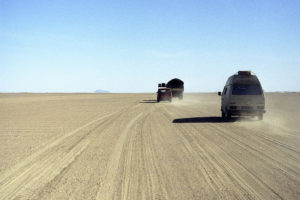


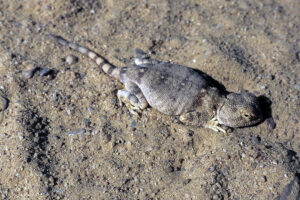
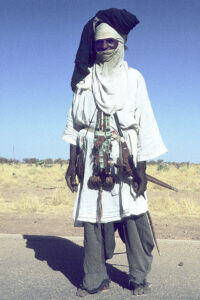
Agadez is a small town – merely a collection of adobe huts, clustered around a mosque with a tall minaret, which is constructed of sun-dried mud bricks. We eat in a small outdoor restaurant near the open-air market – boiled cassava, served in a spicy sauce. In the market, a selection of natural medicines, and amulets, called gri-gri, are for sale – a fantastic collection of snake skins, snakes’ heads, dried lizards, vultures’ heads and claws, animal furs (including genettes), sea shells, bark, etc.
We camp in a small oasis outside town, a forest-like area with numerous doum palms (Hyphaene thebaica), acacias, tamarisks, and other trees. Birdlife is rich here. We observe little green bee-eater (Merops orientalis), blue-naped mousebird (Urocolius macrourus), yellow-breasted barbet (Trachyphonus margaritatus), and others.
Contrary to what we have heard, the new road between Ain Gall and Ain Waggeur has not yet been completed. As it turns out, we have to negotiate the most terrible road, alternating between bumpy gravel, dirt, and pure desert piste with soft sand. Our car gets stuck several times, and again we must make use of our aluminum ladders. The sand here is so fine-grained that it quickly fills up the oil bath in the cooling system of our car, and to prevent the engine from over-heating we must renew the oil in the air filter several times. The plate beneath the van, which covers the steering gear, falls off four or five times, getting so many beatings that it looks like scrap iron.
Not everything is trouble, though. A trotting red-fronted gazelle (Eudorcas rufifrons) stops about a hundred metres away, proceeding to stare at us for some time, and an Arabian bustard (Otis arabs) takes off in front of our car, its white wing patches visible for a long time.
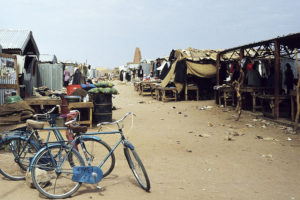
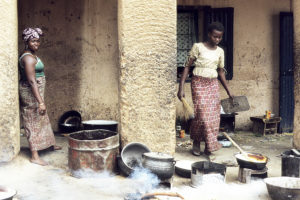
We are now passing through agricultural land, with sugarcane and pumpkin fields. In the small villages, houses are conical, with grass-thatched roofs, ending in a peak. Women dress in brightly coloured garments, whereas men wear coats and hats of various styles, ranging from battered old specimens to huge Mexican-style sombreros. In these parts, the Arabian stamp has almost vanished, replaced by the Black African.
In southern Niger, north of Malbaza, we encounter our first chameleon, an African chameleon (Chamaeleo africanus), which is distributed across the Sahel zone, from Mauritania eastwards to Sudan.
In Kano, northern Nigeria, we camp next to a garbage dump, together with numerous other travellers, among these our former companions in the two overland trucks. As Kano is notorious for thefts, we take turns guarding the camp throughout the night.
On our way towards the Cameroun border, our attention is caught by several gigantic collections of sticks in a couple of huge trees. As it turns out, they are communal nests of white-billed buffalo-weavers (Bubalornis albirostris), a black bird the size of a starling. We also note purple glossy starling (Lamprotornis purpureus), a purplish-blue bird with green wings. A herd of Ankole cattle, characterized by their huge horns, passes by, raising huge clouds of dust.
Around Pulka, the landscape is dominated by low rocky outcrops, eroded into strange shapes. Here we find desert roses (Adenium obesum), displaying masses of large, pink flowers. When we lose our way, we ask some villagers for directions to the border town of Kirawa. The road gradually gets narrower, ending in a path. A group of men direct us to another road, which at one point is barred by a road-block. I jump out of the car to remove it, causing a uniformed man quickly to emerge from a hut.
”What on Earth are you doing?” he exclaims. “This is the border to Cameroun!”
I apologize many times, explaining that we got lost, and immediately he is much friendlier. ”You cannot have your papers stamped here,” he says, explaining to us how to go to Kirawa.
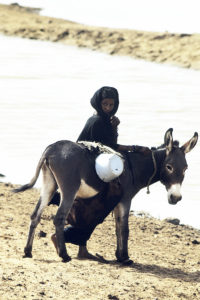
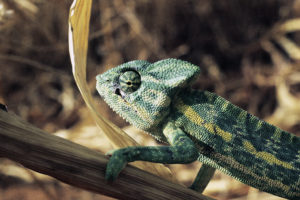
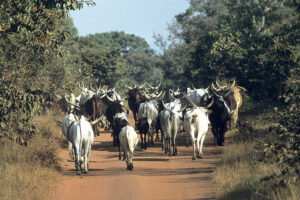
Bird life includes many tropical species, for instance helmeted guineafowl (Numida meleagris), white-faced whistling-duck (Dendrocygna viduata), and African jacana (Actophilornis africanus).
Leaving Waza, we have yet another puncture – one in a long series. When leaving Denmark, we foolishly put tubes into tubeless tyres. These tyres are equipped with a metal frame, which – as it turns out – cuts into the tube. On our way through Europe, we went to Andorra to buy spare tubes, and it seems that they are of inferior quality, as the valves are leaking.
The road across the Kapsiki Mountains is incredibly rough, often consisting of sloping rocks, sometimes with a gradient of 20 degrees, alternating with deep potholes, or protruding rocks, scraping the bottom of our van. Our reward is a wonderful landscape, with dramatically eroded rock formations, numerous villages, whose circular houses are equipped with a pointed grass roof, and extensive millet and cotton fields.
People in this area are beautiful. Older women only wear a skirt, most of the young women also a blouse. Supposedly, they have been taught that you are indeed very primitive if you show your breasts. An old man bursts out laughing, when I photograph him.
Driving at leisure along a somewhat better road, the engine suddenly speeds up, and the gas cable is stuck. Hurriedly, we turn off the engine and descend to inspect the damage. As it turns out, the engine suspension has broken, and engine and gear box are now hanging a few inches above the ground! Placing the wire of our small winch all the way around the body of our van, we manage to raise the engine, almost to its initial position. Full of fear, we start the engine and test clutch and gears. They seem to work, so, at a snail’s pace, we drive to the nearest town, where the suspension is welded back in place.
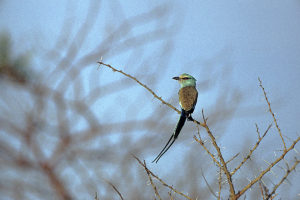
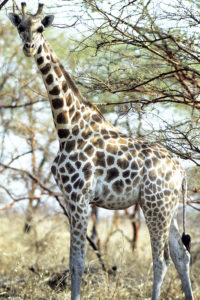
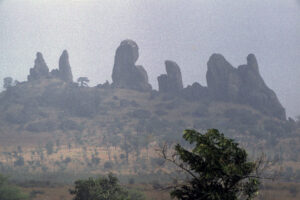
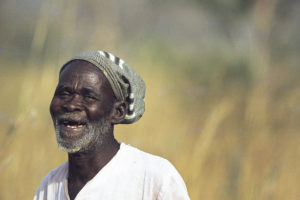
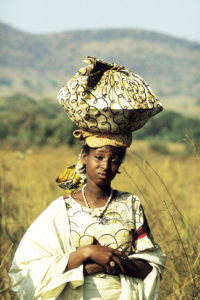

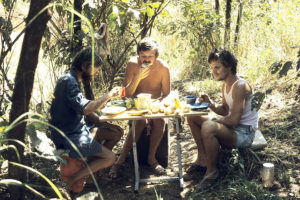
We have now entered the rainforest zone, but most of the forest has been cleared to create farmland, leaving only minor enclaves of rainforest, which contain a few huge trees, some with broad buttresses. In many of the cleared areas, the soil has been depleted of nutrients, and secondary forest has conquered the abandoned fields.
In Bouar, a police officer informs us that the road ahead is blocked by parades, celebrating the National Day. A huge crowd is watched over by long ranks of soldiers, some of whom are clad in partisan uniforms. Everybody is dressed up to the nines, some wearing European style clothes, others tribal costumes, with a naked torso, but sporting brightly coloured bathing trunks. We make a stop to do some shopping, but when we intend to leave, an excited police officer waves our car aside.
“Don’t you know that a cortège is going to pass?”
“No, we’re sorry, we had no idea!”
When the cortège has passed the officer leaves us, and we are able to continue our journey. On our way towards Bangui, the capital of the Central African Republic, I am unfortunate enough to kill a chicken, crossing the road. Of course, I could just choose to ignore it, but I am curious to see what this can lead to, so I stop at the roadside. The owner of the chicken comes running, asking an outrageous price for the dead bird. We immediately decline. Time passes, and the price is lowered bit by bit – until she suddenly produces six eggs, which, she claims, the chicken was incubating before its untimely death. We don’t know what to think, but, finally, we buy chicken, as well as eggs, at a reasonable price. Our meal this evening is curried chicken. As it turns out, it is extremely tough. Chicken’s revenge!
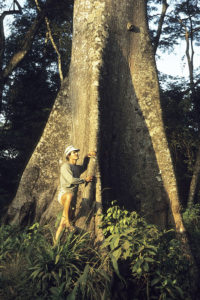
Until now we have had no difficulties obtaining visas for the various countries we have visited, and we expect to get visas for Zaire in Bangui. At the embassy, however, we learn that our visas should have been issued, before we left Denmark. When we inform the staff that there is no Zaire embassy in Denmark, they hand us visa forms, at the same time assuring us that we may not get a visa. During the following days, we pester them, among other things informing them (falsely) that I have a sick uncle in Tanzania, who is waiting for us. They couldn’t care less, but instruct us to bring a letter from a Danish foreign mission, stating that we are respectable citizens, who are able to take care of ourselves. If not, we can forget everything about getting a visa. We take it for granted that there is no Danish consulate in Bangui.
Instead, we investigate the possibilities of obtaining a visa for the Sudan. At the Sudanese Embassy we are informed that they don’t issue visas, as the road in the border region between the Central African Republic and the Sudan is blocked due to excessive rain in the last few months. This is simply not true, as we have just talked to travellers, who came from the Sudan, and, according to their information, the road is drying out. At the embassy, we talk to another employee, who informs us that we can obtain visas, if we make a bank deposit of 50,000 CFA (a Central African currency) per person, covering a driving permit.
We do as we are told. But now the staff informs us that their duplicator has broken – and they won’t accept photo copies of our proof of deposits. Sheer malice! Then all offices shut down for the weekend. Sulking, we stroll down the main street of Bangui, cursing bureaucracy. A lady, passing by, hears us talking in Danish, and asks us, in fluent Danish, what we are doing here. As it turns out, she is a Dane, married to a Frenchman who is employed in Bangui. She invites us for dinner, and during our conversation she informs us that Bangui does indeed have a Danish consulate, close to the roundabout, which we have been passing several times in the last few days, not noticing the fluttering Danish flag. How dull can you possibly be?
Monday morning sees us in the Danish consulate, where the nice secretary creates a letter, written on the consulate’s official paper, stating that we are respectable and solid citizens who will not become an economic burden for the Zaire government. Before bringing this valuable document to the Zaire Embassy, we go to the Sudan Embassy to collect our passports. Luckily, they still haven’t issued our visas, and our deposits are returned. All we have to do now is to wait for our visas for Zaire.
During our two weeks’ stay at the river bank, we have made friends with five Germans. Franz and Gizela, a married couple, and their friend Albert, are driving in a small car, quite similar to our VW van, while Jürgen and Wolfgang are the proud owners of a huge, powerful Deutz truck. All five of them are going the same way as we, from Zongo, on the opposite river bank, via Gemena, Lisala, and Isiro to eastern Zaire. Franz, Gizela, and Albert had already left for Zongo, but ran into a problem, because their visas for Zaire had expired. They therefore had to return to Bangui to have their visas renewed. Now they learn that we also get visas for Zaire, and they promise to wait for us in Zongo. Jürgen and Wolfi decide to join us on the ferry across the river.
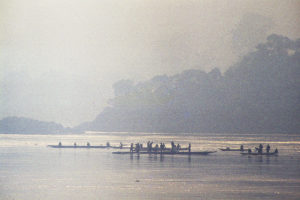
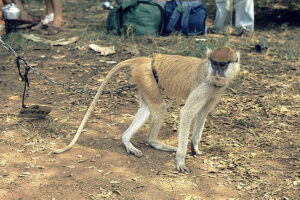
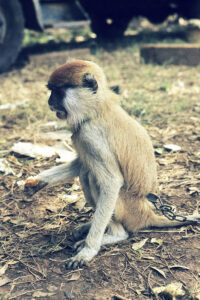
Again, we join company with Franz, Gizela, and Albert, whereupon we immediately commence our journey towards Boyabu, driving through fine rainforest. For the first 20 km or so, the road is fairly good, but then trouble starts. We arrive at an utterly terrible stretch of road, completely spoiled by huge trucks, which have left deep, muddy wheel tracks. Two German Mercedes vans are helplessly stuck. Our friends in the Deutz try to pull them out, but they are too heavy. For the rest of this day they block the road, and we spend the night at the roadside.
The ‘fun’ continues the following morning. Finally, the two Mercedes vans are pulled out, and their owners decide to return to Zongo. The tracks are so deep that we must drive with one pair of wheels in the middle and the other pair deep into a ditch. The side of our van is scraping on the road side, which means that two or three persons must run alongside the van, pushing it out from the side, to prevent it from getting stuck. During these efforts, our rear bumper is torn off.
This exhausting work occupies most of the day. In the afternoon, we arrive at a deep mudhole, which we – rather foolishly – attempt to cross. Soon we are hopelessly stuck, with engine and gear box under water. Wolfi and Jürgen try to pull us out, but the wire bursts. Luckily, a truck from Zongo arrives, pulling out our VW backwards. Now the Deutz is able to gain enough speed to pull our car across the mudhole, but a bit later we must stop, as our clutch is not functioning. From the front axle of the VW, we tie a rope to the truck, which, on the following day, simply pulls our car most of the time. This is a fine arrangement, until one of our steering bars is bent, looking like a broad U. We straighten it, using our winch, and continue for a short while, until it bends again. We decide to make a stop to repair clutch as well as steering bar.
The engine of the VW is taken out – a horrible sight. It is completely smeared in mud, and we spend quite some time cleaning engine as well as clutch. We also have to clean our generator to make it charge. Meanwhile Franz solves the problem with the bent steering bar, by putting a solid iron bar inside the hollow bar. As a truck is blocking our way, we spend yet another night at the road side.
The following day, when the truck has been removed, the two smaller vehicles are pulled across the mudholes by the Deutz. Now the worst part of road is done with – we think. On a fairly fine stretch, however, there are two very deep holes, where even the Deutz is stuck. Fortunately, other trucks can help, and soon the Deutz is able to pull the smaller cars across. For long periods of time, we must wait for help, and we spend two days in this area. During our inactive periods, we study other travellers, or watch birds in the forest, among these great blue turaco (Corythaeola cristata), grey-cheeked hornbill (Bycanistes subcylindricus), brown-cheeked hornbill (B. cylindricus), white-throated bee-eater (Merops albicollis), and olive-bellied sunbird (Cinnyris chloropygius).
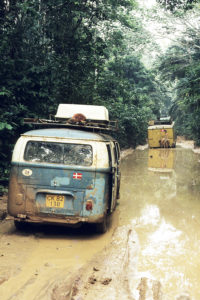

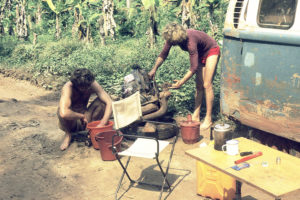
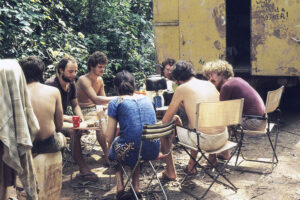
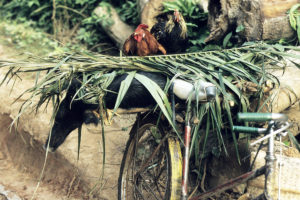
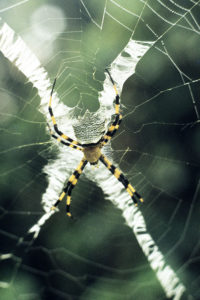

At Bogilima, we must cross a river by ferry. Officially, all ferries in Zaire are free – but rules are one thing, realities another. We have to pay a rather nasty price, before the ferrymen are willing to take us across. To enter the ferry, we must drive on two broad planks, placed at a rather steep angle between the shore and the ferry, the distance between them equal to the distance between the wheels. This is quite nerve-racking, but we succeed in driving all three cars on board without mishap.
Generally, the road is in a much better condition between Gemena and Lisala, although there are also some very bad stretches. By now, we are utterly tired of these miserable roads, and in Bumba we decide to load the cars onto a train, leaving for Isiro. This turns out to be a very relaxing trip, lasting four days. Most of the time, the train moves at a snail’s pace, and from the top of the truck we can enjoy the landscape, alternating between forests, rivers, farmland, and villages.
Refreshed, we arrive at Isiro, from where we continue by car. Compared to western Zaire, the roads in this area are of a superb quality.
